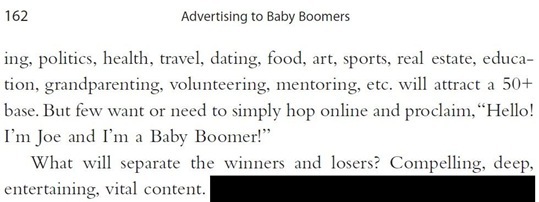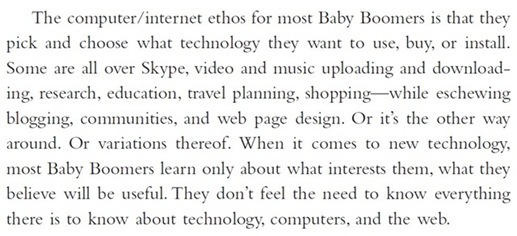Over a month ago I blogged a New York Times piece:
That NYT piece spawned others, including:
From my book:
Here’s what’s going on: Many boomers (along with every other demo) are jobless – or afraid of losing their jobs:
Longer Unemployment for Those 45 and Older
By MICHAEL LUOWorkers ages 45 and over form a disproportionate share of the hard-luck recession category, the long-term unemployed — those who have been out of work for six months or longer, according to the Bureau of Labor Statistics.
How do you keep your job or get a new one? Make sure you’re really tech-savvy:
From my book:
The big buzz phrase today is social networking. Because Boomers are worried about their work-related competencies, all of a sudden they’re diving into Facebook, LinkedIn, are Twittering, etc. to find out about it all and make connections.
But is this roiling ether the best place for advertising?
Me commenting on the NYT article:
As far as Boomers being tech/web Luddites - I’ve been dispelling that silly myth for years - in my book and blog (Advertising to Baby Boomers, first published in early 2005).
But monetizing social networking sites … well, they still haven’t been able to do that with the Millennial and Gen Y demos. What makes anybody think you can do it with Boomers?
Someone commenting on the A-Twitter article:
Drivel Indeed
How many people I'm "twittering" with doesn't tell me much of anything. I want to know how it translates into sales.
Nielsen has an interesting take on it all:
I predicted a bit of this back in November 2008:
Baby Boomers & The Economic Collapse
And if you watched the video above, you know that this isn’t an either/or for advertisers. But if you had to pick one …
Who’s Afraid of the Big Bad Bloggers?
A BIGresearch survey conducted in mid-2008 found that blogs influenced only 3.3% of adults in their apparel purchases. A Harris Interactive poll showed that bloggers were rarely the first source used when considering purchasing decisions.
Kit Simpson deconstructs the recent Kmart WOMM campaign:
Kmart goes to the Twits
When it comes to social network marketing, success comes in being able to do it -- not whether it actually boosts sales … If each of the 6,000 people went to Kmart and bought $100 worth of merchandise, that would represent roughly three and a half one hundredths of one percent of their revenue. (To be precise, it would be 0.003529411764705882% -- but let's not get picky.)
For the umpteenth time …
The Most Effective Marketing/Advertising Model For Reaching Baby Boomers: What is now called traditional advertising pushing you to an age-friendly, informative product/services web site.




No comments:
Post a Comment
Note: Only a member of this blog may post a comment.